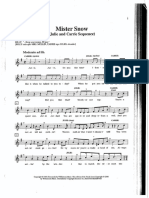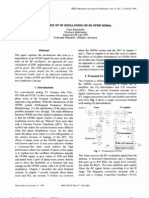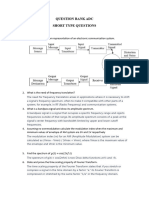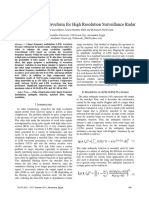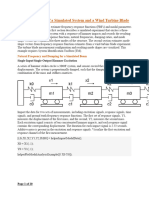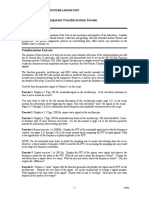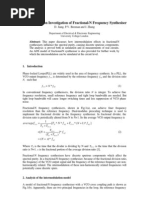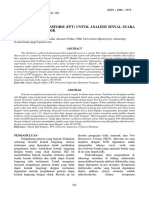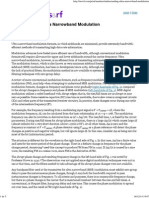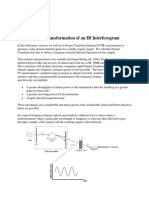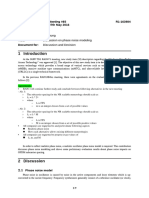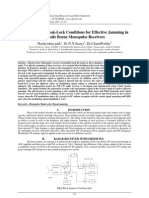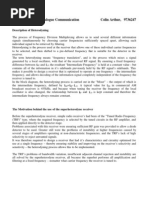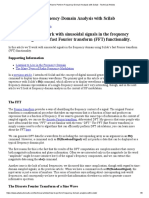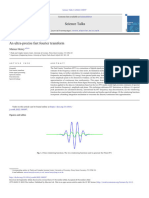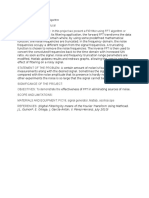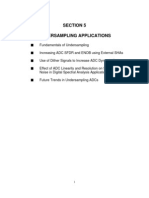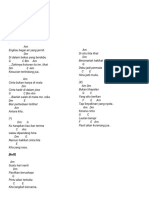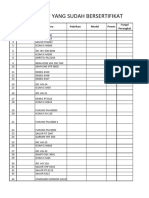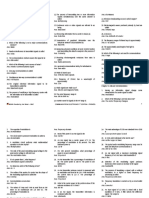Near Unity Spurs Theory: Trident P2 Fgu 400/800Mhz
Near Unity Spurs Theory: Trident P2 Fgu 400/800Mhz
Uploaded by
Iris ShtraslerCopyright:
Available Formats
Near Unity Spurs Theory: Trident P2 Fgu 400/800Mhz
Near Unity Spurs Theory: Trident P2 Fgu 400/800Mhz
Uploaded by
Iris ShtraslerOriginal Description:
Original Title
Copyright
Available Formats
Share this document
Did you find this document useful?
Is this content inappropriate?
Copyright:
Available Formats
Near Unity Spurs Theory: Trident P2 Fgu 400/800Mhz
Near Unity Spurs Theory: Trident P2 Fgu 400/800Mhz
Uploaded by
Iris ShtraslerCopyright:
Available Formats
Trident P2 FGU 400/800MHz
Near Unity Spurs Theory
7/31/2016
Motorola Confidential Proprietary
Created by Sergey Anderson BSA036
Trident P2 FGU 400/800MHz
Near Unity Spur Theory
Near unity spurs or Fractional-N spurs are considered as the spurs coming out of the
synthesizer due to its fractional divider. Formerly, the frequency spur calculation was
based on the following formula for the near unity spur investigation:
Fspur Fref REM
(1)
where Fref - reference frequency at the phase detector input;
REM fractional remainder of the total divide ratio.
The formula above does not include all possible offset combinations for fractional
synthesizer and should be converted to another useful form. It is well known from the
fractional synthesizer theory that the fractional spur can be located as close as (Fref/F) Hz
away from the carrier and it can be found using the following formula:
Fspur
Fref
F
(2)
where Fref - reference frequency at the phase detector input.
F accumulator value for existing divide ratio of the synthesizer.
In other words, the fractional spur offset is equal to the current fractional resolution. The
fractional resolution is the frequency distance between the current carrier frequency of
the synthesizer and the nearest virtual frequency with only the integer part of the divide
ratio (REM=0). This principle is easy to use for fractional spur understanding and also for
spur measurement algorithm.
For TETRA standard there are two frequency channel steps 12.5 kHz and 6.25 kHz for
the synthesizer in locked mode and an additional 0.5Hz step for AFC correction.
The worst case fractional spur settings for an ideal system could be found from formulas
(2) and (3):
Fspur
Fref
F
F 1
(3)
However, in practice those formulas are not useful either.
7/31/2016
Motorola Confidential Proprietary
Created by Sergey Anderson BSA036
Trident P2 FGU 400/800MHz
A new useful formula was found for the frequency offset calculation of the Near Unity
spurs (4). This formula is based on both synthesizer theory and the harmonics effect in
active elements, and corresponds with RF measurements.
There are few assumptions for Near Unity effect:
1. Each fractional spur goes from fractional divider into the phase detector and
produces two spurs near the carrier frequency on the left and right sides.
Thus, one fractional spur always produces two frequency spurs with the same
frequency offsets (left/right sides) from the carrier.
2. The fractional spurs amplitude depends on the fractional number and
also depends on TCXO, VCO, Phase Detectors performances, IC designs and
PCB board design. Because of many uncontrolled effects, the fractional spur
can become either worse or better. In that way, all possible offset combination
should be calculated and measured.
3. The fractional divider produces all harmonics of the fractional spurs.
4. The fractional spur offset could be reduced by the number N if there are any
additional frequency dividers with divide ratio N at the prescaler input.
Fspur n Fvco Fref k
(4)
where n harmonics number,
k integer number can be found by following expressions:
k INT
Fvco
Fref
if
0 REM
Fvco
Fref
0 .5
and
k 1 INT
Fvco
Fref
Fspur 0 ,
if
if
0.5 REM
REM
Fvco
Fref
Fvco
Fref
Note:
7/31/2016
Motorola Confidential Proprietary
Created by Sergey Anderson BSA036
Trident P2 FGU 400/800MHz
Examples
TETRA UHF standard
Frequency step=12.5kHz; Frequency band 700-940MHz; Ref.Freq.=8.4MHz; Rodinia
frequency pre-divider N=3; Total number of all possible fractional spurs=9408.
1) Fvco=705.6MHz
Using the formula (4) will yield:
Remainder=REM [705.6/8.4]=0, then
Fspur= n*[705.6-8.4*84]=0, - no any fractional spur.
2) Fvco=705.5875MHz
Remainder=REM [705.5875/8.4]=0.998511
REM>0.5, then K=1+INT [705.5875/8.4]=1+83=84
Fspur= n*[705.5875-8.4*84]= n*0.0125 MHz
Because of using the Rodinia Pre-divider N=3:
Fspur=n*0.0125/3=n*0.004166 MHz, where n harmonics number.
3) Fvco=705.6125MHz
Remainder=REM [705.6125/8.4]= 0.001488
REM<0.5, then K=INT [705. 6125/8.4] =84
Fspur= n*[705. 6125-8.4*84] = n*0.0125 MHz
Because of using the Rodinia Pre-divider N=3:
Fspur=n*0.0125/3=n*0.004166 MHz, where n harmonics number.
7/31/2016
Motorola Confidential Proprietary
Created This
by Sergey
Region is Anderson BSA036
longer at
2.682V
You might also like
- Christmas GraceDocument13 pagesChristmas GraceJoy Salas LobridoNo ratings yet
- Carousel Vocal ScoreDocument134 pagesCarousel Vocal Scoreshelby p56% (9)
- Low Light SourceDocument9 pagesLow Light SourcetrevnarkNo ratings yet
- FMS CMA-900 929-600006-000ep InstallDocument276 pagesFMS CMA-900 929-600006-000ep Installesedgar100% (2)
- VHF Radar Target Detection in The Presence of Clutter: Boriana VassilevaDocument8 pagesVHF Radar Target Detection in The Presence of Clutter: Boriana VassilevaGhada HamzaNo ratings yet
- Integer Boundary Spurs FF PLLs - WHP - 20160728 - 1Document8 pagesInteger Boundary Spurs FF PLLs - WHP - 20160728 - 1余波(菠菠菜)No ratings yet
- TFCLEAN: Time-Frequency Noise Suppression: TopicsDocument14 pagesTFCLEAN: Time-Frequency Noise Suppression: TopicsVijay YadavNo ratings yet
- Influence of RF Oscillators On An Ofdm SignalDocument12 pagesInfluence of RF Oscillators On An Ofdm SignalLi ChunshuNo ratings yet
- Fundamentals of Spectrum AnalyzerDocument82 pagesFundamentals of Spectrum AnalyzerTrần Châu ThôngNo ratings yet
- ADC QB SolutionsDocument15 pagesADC QB Solutionssandeep kumar yadavNo ratings yet
- Lecture 16: Spectral Filtering: C Christopher S. Bretherton Winter 2015Document3 pagesLecture 16: Spectral Filtering: C Christopher S. Bretherton Winter 2015Priyo TenanNo ratings yet
- Sampling Random Signals in A Fractional Fourier Tao Zhang, Wang, 2010)Document7 pagesSampling Random Signals in A Fractional Fourier Tao Zhang, Wang, 2010)Arturs AboltinsNo ratings yet
- Efficient NLFM WaveformDocument5 pagesEfficient NLFM WaveformIndir JaganjacNo ratings yet
- U3741BMDocument32 pagesU3741BMOlga PlohotnichenkoNo ratings yet
- DECONZ: Zero-Phase Deconvolution: TopicsDocument20 pagesDECONZ: Zero-Phase Deconvolution: TopicsVijay YadavNo ratings yet
- Parallel FiltersDocument5 pagesParallel FiltersAdi PopaNo ratings yet
- Diseño de Filtros IIR y FIRDocument11 pagesDiseño de Filtros IIR y FIRacajahuaringaNo ratings yet
- FFTs and Oscilloscopes A Practical GuideDocument8 pagesFFTs and Oscilloscopes A Practical GuidecasagrandeNo ratings yet
- Modal Analysis of A Simulated System and A Wind Turbine Blade ExampleDocument20 pagesModal Analysis of A Simulated System and A Wind Turbine Blade ExampleSulaiman AL MajdubNo ratings yet
- Re Previous Q&a-Mid-2Document71 pagesRe Previous Q&a-Mid-2kalvapudimukeshNo ratings yet
- Orientation and Equipment Familiarization SessionDocument1 pageOrientation and Equipment Familiarization Sessionbill obrienNo ratings yet
- Phase NoiseDocument4 pagesPhase NoisetranthinhamNo ratings yet
- Intermodulation Investigation of Fractional-N Frequency SynthesiserDocument4 pagesIntermodulation Investigation of Fractional-N Frequency SynthesiserVladimir ShamshinNo ratings yet
- Design of A Spurious-Free RF Frequency Synthesizer For Fast-Settling ReceiversDocument12 pagesDesign of A Spurious-Free RF Frequency Synthesizer For Fast-Settling ReceiversHakan ÇaylakNo ratings yet
- Fast Fourier Transform (FFT) Untuk Analisis Sinyal Suara Doppler UltrasonikDocument8 pagesFast Fourier Transform (FFT) Untuk Analisis Sinyal Suara Doppler UltrasonikardiNo ratings yet
- Pitch Tracking - ACF - BABU ARUN KR.Document6 pagesPitch Tracking - ACF - BABU ARUN KR.AnshNo ratings yet
- Mixer 1Document59 pagesMixer 1bayman66100% (1)
- Optimal Filter: 'Truncation Time For Matched Array ProcessingDocument4 pagesOptimal Filter: 'Truncation Time For Matched Array ProcessingMayssa RjaibiaNo ratings yet
- Eusipco2009 FinaleDocument5 pagesEusipco2009 FinalenahelaAliNo ratings yet
- CZT Vs FFT: Flexibility Vs SpeedDocument8 pagesCZT Vs FFT: Flexibility Vs SpeedMuhammad Jalal AldeenNo ratings yet
- Lab-10 Fourier TransformDocument3 pagesLab-10 Fourier TransformAbdullah IbrahimNo ratings yet
- Wind Canceller and DMTIDocument6 pagesWind Canceller and DMTIMiguel Andres AlonsoNo ratings yet
- Understanding Ultra Narrowband ModulationDocument5 pagesUnderstanding Ultra Narrowband ModulationoldjanusNo ratings yet
- Fourier Transformation of An IR InterferogramDocument12 pagesFourier Transformation of An IR InterferogramIvt RomeroNo ratings yet
- 3GPP Phase NoiseDocument9 pages3GPP Phase Noiserohanshreemurthy1997No ratings yet
- Sampling: 0 Pre-Laboratory ReadingDocument10 pagesSampling: 0 Pre-Laboratory ReadingSamuel TanNo ratings yet
- Unit 2 - Radar Engineering - WWW - Rgpvnotes.inDocument16 pagesUnit 2 - Radar Engineering - WWW - Rgpvnotes.inPranav ChaturvediNo ratings yet
- Spectrum Analysis and The Frequency DomainDocument16 pagesSpectrum Analysis and The Frequency DomainAhsan AmeenNo ratings yet
- Estimation of Break-Lock Conditions For Effective Jamming in Missile Borne Monopulse ReceiversDocument7 pagesEstimation of Break-Lock Conditions For Effective Jamming in Missile Borne Monopulse ReceiversIJERDNo ratings yet
- 19.325 Project 1 - Analogue Communication Colin Arthur, 9736247Document4 pages19.325 Project 1 - Analogue Communication Colin Arthur, 9736247Ali Abou RashedNo ratings yet
- Lab.4&5. FIR FiltersDocument7 pagesLab.4&5. FIR Filtersآيـة جمال عبد الفتاح الراويNo ratings yet
- Lab.4&5. FIR FiltersDocument7 pagesLab.4&5. FIR FiltersKen MutaiNo ratings yet
- Uhf Ask Receiver IC U3741BM: FeaturesDocument33 pagesUhf Ask Receiver IC U3741BM: FeaturesBegu CataNo ratings yet
- How To Perform Frequency-Domain Analysis With Scilab - Technical ArticlesDocument8 pagesHow To Perform Frequency-Domain Analysis With Scilab - Technical ArticlesRadh KamalNo ratings yet
- Pulses PDFDocument16 pagesPulses PDFAnonymous AFFiZnNo ratings yet
- Spectral Repeat Finder (SRF) : Identification of Repetitive Sequences Using Fourier TransformationDocument17 pagesSpectral Repeat Finder (SRF) : Identification of Repetitive Sequences Using Fourier TransformationSamir SabryNo ratings yet
- Spectrum Analysis and The Frequency DomainDocument10 pagesSpectrum Analysis and The Frequency Domainer.ankurtripathiNo ratings yet
- EEELE445 Lab 8: AM Superheterodyne Receiver: PurposeDocument5 pagesEEELE445 Lab 8: AM Superheterodyne Receiver: PurposeKarim HashemNo ratings yet
- An Ultra Precise Fast Fourier Transform - 2022 - Science TalksDocument17 pagesAn Ultra Precise Fast Fourier Transform - 2022 - Science Talksalbertus tuhuNo ratings yet
- Ce Nov 19 R17Document18 pagesCe Nov 19 R17Anonymous yO7rcec6vuNo ratings yet
- Cepstrum vs. LPC: A Comparative Study For Speech Formant Frequencies EstimationDocument16 pagesCepstrum vs. LPC: A Comparative Study For Speech Formant Frequencies Estimationmalathi sharavananNo ratings yet
- FIR Filter Using FFT AlgorithmDocument1 pageFIR Filter Using FFT Algorithmnadyn brucalNo ratings yet
- Spectral Efficiency Analysis in OFDM and OFDM/OQAM Based Cognitive Radio NetworksDocument5 pagesSpectral Efficiency Analysis in OFDM and OFDM/OQAM Based Cognitive Radio NetworksTrần Mạnh HùngNo ratings yet
- Lab 5Document11 pagesLab 5Kishore KumarNo ratings yet
- IQdemodulationDocument13 pagesIQdemodulationRaša VladikovićNo ratings yet
- Section 5 Undersampling ApplicationsDocument33 pagesSection 5 Undersampling Applicationschocobon_998078No ratings yet
- Notes On Fourier Analysis: The Basics and BeyondDocument8 pagesNotes On Fourier Analysis: The Basics and BeyondV.RamachandranNo ratings yet
- Filter Bank: Insights into Computer Vision's Filter Bank TechniquesFrom EverandFilter Bank: Insights into Computer Vision's Filter Bank TechniquesNo ratings yet
- Adaptive Filter: Enhancing Computer Vision Through Adaptive FilteringFrom EverandAdaptive Filter: Enhancing Computer Vision Through Adaptive FilteringNo ratings yet
- Software Radio: Sampling Rate Selection, Design and SynchronizationFrom EverandSoftware Radio: Sampling Rate Selection, Design and SynchronizationNo ratings yet
- Multifrequency Electron Paramagnetic Resonance: Theory and ApplicationsFrom EverandMultifrequency Electron Paramagnetic Resonance: Theory and ApplicationsSushil K. MisraNo ratings yet
- ADVANCED - MusicDocument4 pagesADVANCED - MusiccasadevalleaNo ratings yet
- GUL - DER - ZXSDR BS8800 Product DescriptionDocument49 pagesGUL - DER - ZXSDR BS8800 Product DescriptionJacob ObboNo ratings yet
- Hit Song Chord Volume 1Document48 pagesHit Song Chord Volume 1MOHAMED QADRI BIN MOHAMED SAHAIMI MoeNo ratings yet
- Datasheet: Ultra-Broadband AmplifierDocument17 pagesDatasheet: Ultra-Broadband AmplifiercarlosNo ratings yet
- Preludium I Fuga A-Moll-Armonica 4Document2 pagesPreludium I Fuga A-Moll-Armonica 4bartdk2No ratings yet
- 3.3.1.2 Longitudinal and Transverse WavesDocument38 pages3.3.1.2 Longitudinal and Transverse Wavesarychan418No ratings yet
- Rules For Pratiyogita 2024.DOC Website1 2Document6 pagesRules For Pratiyogita 2024.DOC Website1 2harpalsewak2No ratings yet
- Easy On Me (C)Document2 pagesEasy On Me (C)Moacir RodriguesNo ratings yet
- AVR-55 (SM) PDFDocument84 pagesAVR-55 (SM) PDFJory2005No ratings yet
- 7SR210 and 7SR220 Argus Catalogue SheetDocument16 pages7SR210 and 7SR220 Argus Catalogue SheetKunjan DalwadiNo ratings yet
- Newtec QPSKPDFDocument17 pagesNewtec QPSKPDFIbrahim QaidNo ratings yet
- Chapter 4Document41 pagesChapter 4jennycakez97No ratings yet
- A. Complete The Sentences With Suitable Articles. If No Article Is Needed, Put An X' in The SpaceDocument2 pagesA. Complete The Sentences With Suitable Articles. If No Article Is Needed, Put An X' in The SpaceLorraine TsoiNo ratings yet
- Stairway To Heaven - Led ZappelinDocument6 pagesStairway To Heaven - Led ZappelinKamal Edlin HusinNo ratings yet
- Daftar Perangkat VHFDocument2 pagesDaftar Perangkat VHFbebeniben8No ratings yet
- BOSS Guide 3883 Vol19 - 72Document41 pagesBOSS Guide 3883 Vol19 - 72Nelson Z Z Tapia100% (1)
- Its The Music Satb - Hine 213996dlDocument4 pagesIts The Music Satb - Hine 213996dldelrayoantonioNo ratings yet
- AIMCAT CAT TestDocument34 pagesAIMCAT CAT TestPawan S. RajputNo ratings yet
- How To Grind (For Guys) 11 Steps (With Pictures)Document2 pagesHow To Grind (For Guys) 11 Steps (With Pictures)Jay BlackwoodNo ratings yet
- L3harris RF 7850m HH Multiband Networking Handheld Radio Datasheet Cs TcomDocument2 pagesL3harris RF 7850m HH Multiband Networking Handheld Radio Datasheet Cs TcomazizrakouchNo ratings yet
- The Top 100 Greatest Motown SongsDocument3 pagesThe Top 100 Greatest Motown Songsrrr4450% (2)
- 2021 Computational Approach To Track Beats in Improvisational Music PerformanceDocument5 pages2021 Computational Approach To Track Beats in Improvisational Music PerformanceRahul KodagNo ratings yet
- 2g 3g Mobile Package 2011 PDFDocument794 pages2g 3g Mobile Package 2011 PDFRedro NosmircNo ratings yet
- BBC LEARNING ENGLISH - Vocabulary OnomatopoeiaDocument6 pagesBBC LEARNING ENGLISH - Vocabulary OnomatopoeiaFajar BahariNo ratings yet
- Commscope - Multi Beam Antenna SystemDocument16 pagesCommscope - Multi Beam Antenna SystemNataša Mihić BoskovićNo ratings yet
- R1-071245 (Approved ReportWG1 #47bis)Document118 pagesR1-071245 (Approved ReportWG1 #47bis)DellNo ratings yet
- Frenzel Qa PDF FreeDocument19 pagesFrenzel Qa PDF FreeIra CervoNo ratings yet

